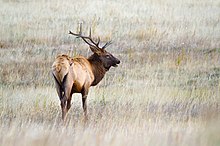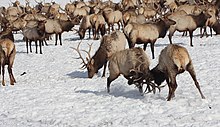Elk have thick bodies with slender legs and short tails. They have a shoulder height of 2 ft 6 in – 4 ft 11 in with a nose-to-tail length of 5 ft 3 in – 8 ft 10 in. Males are larger and weigh 392–1,096 lb while females weigh 377–644 lb. The largest of the subspecies is the Roosevelt elk, found west of the Cascade Range in the U.S. states of California, Oregon and Washington, and in the Canadian province of British Columbia.

Roosevelt elk have been introduced into Alaska, where the largest males are estimated to weigh up to 1,300 lb. More typically, male Roosevelt elk weigh around 701 to 1,100 lb, while females weigh 575 to 624 lb. Male tule elk weigh 450–701 lb while females weigh 375–421 lb. The whole weights of adult male Manitoban elk range from 635 to 1,054 lb. Females have a mean weight of 606 lb. The elk is the second largest extant species of deer, after the moose.

Antlers are made of bone, which can grow at a rate of 1 inch per day. While actively growing, a soft layer of highly vascularized skin known as velvet covers and protects them. This is shed in the summer when the antlers have fully developed. Bull elk typically have around six tines on each antler. The Siberian and North American elk carry the largest antlers while the Altai wapiti has the smallest. Roosevelt bull antlers can weigh 40 lb. The formation and retention of antlers are testosterone-driven, In late winter and early spring, the testosterone level drops, which causes the antlers to shed.

Summer elk range is typically within a ½ mile of water. Winter range is often the limiting factor for elk herds as only about 10 percent of their total habitat is winter range. Elk prefer the summer range, moving to high elevations early and staying until absolutely forced down by snow depth. Summer range varies from 7,000 feet in the mixed conifers to 10,000+ in the spruce fir-sub-alpine belt. Winter range varies from 5,500 to 6,500 feet in Arizona, the pinyon-juniper zone.
